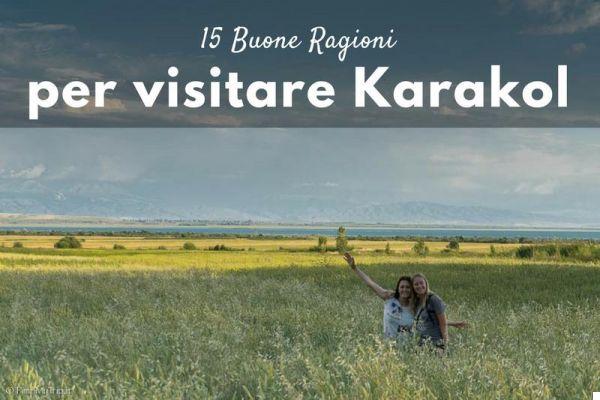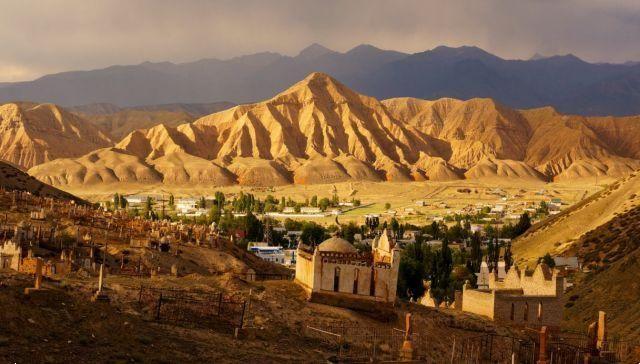"Kirghi-cheeee? ..." was the first thing most people said to me before I left for the Kyrgyzstan. While still largely unknown, this little gem among the Central Asian states is a must-visit country.
The kindness of the people, the varied cuisine (thanks to the Chinese influence) and the fact that there are community tourism projects (such as the CBT – Community Based Tourism), make it a country in many ways easier than you might think.
In any case, this guide tries to provide all the information you need to better organize your trip.
- Before leaving
- How much does it cost to travel to Kyrgyzstan?
- Places to see
- Experiences not to be missed
- Dishes to Taste Absolutely
- How to get around
- Security in Kyrgyzstan
ATTENTION UPDATE 2019
Finally it is possible to book i TOUR ONLINE con Get Your Guide!
Why you should book them with Get Your Guide:
- There are very reliable
- Book online e you can cancel up to 24 hours in advance
- They also include the private transport
- They are particularly recommended if you are short on time (public transport is very slow)
- They have local contacts
- They practically include everything: accommodation, transport and dinners (see depending on the tour)
SEE HERE ALL THE AVAILABLE TOURS
Before leaving
Information on Kyrgyzstan
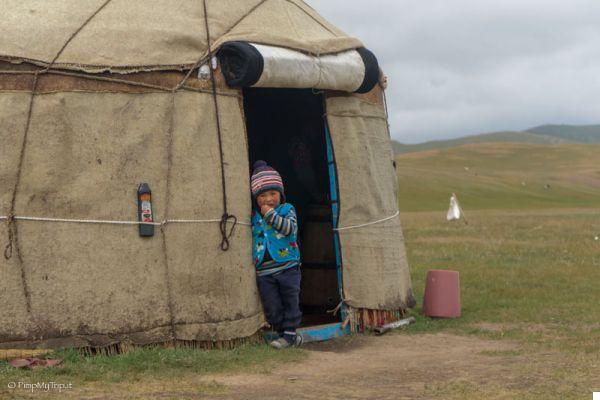
A traditional Kyrgyz yurt
For more than two millennia the Silk Road it was the main route for trade between East and West, but not only. The Silk Road was not just a road for the transport of goods: it was the place where ideologies, different cultures, religions and men met.
One of its main arteries passed right through Kyrgyzstan offering, with its mountain ranges, breath from the heat and desert of the surrounding countries and even today travelers can travel it, by car, by bike, on foot or on horseback.
Kyrgyzstan is home to two magnificent mountain ranges, the catena del Tien Shan and that of Pamir-Alai which make up more than 90% of this small country in the heart of Central Asia. With 29 peaks over 4000 meters, its views have earned Kyrgyzstan the name of the Land of the Celestial Mountains.
The town offers trekking lovers more than 200 different paths to be covered on foot or on horseback. Its more than 50 national parks offer sportspeople an ideal setting for all forms of sports (even extreme ones) as well as preserving a nature that is still intact and uncontaminated.
Kyrgyzstan has also kept its deep identity intact: even today, in summer, families move to the pastures accompanying the cattle, thus preserving the ancient traditions of nomadic life.
The Kyrgyz people are also very hospitable. Although tourism is fairly unknown (for now), locals are happy to see foreign faces in their country and welcome tourists with open arms.
When to Go and Kyrgyzstan's Climate
Kyrgyzstan, having no access to the sea, has a continental type climate. Having about 94% of the territory made up of mountainous reliefs, thewinter is cold (although temperatures have risen in recent years) and hot summers (but in the mountains if you are trekking bring a duvet and woolen socks because in the evening it is cold and it is not uncommon for there to be sporadic snowfalls on the passes).
The best months to visit Kyrgyzstan are definitely the summer ones. In spring (until late May) there is still snow in the mountains and on the passes. July e August these are the best months and since Kyrgyzstan is not a mass tourism destination you will not find crowds even in the most touristic places. September like spring can be cold, at least in the mountains, so if you want to go trekking, be prepared.
Pros and Cons of a trip to Kyrgyzstan
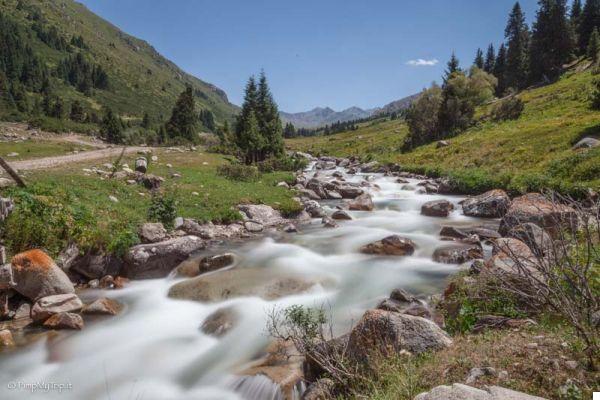
That's why Kyrgyzstan is called the "Switzerland of Central Asia"
Surely among the pros to include the fact that for stays of less than 60 days for Spanish citizens it is not necessary to obtain a visa. This makes Kyrgyzstan the gateway to Central Asia and certainly a preferred channel for tourism.
The language barrier is a problem especially if you want to spend a few days in the mountains or in yurts.
La driving and traffic accidents they are the big problem of Kyrgyzstan. Drivers have a habit of putting too much foot on the accelerator pedal and the roads are not always in excellent condition, quite the contrary. The safest thing is to avoid public transport and rely on an experienced driver.
How much does it cost to travel to Kyrgyzstan?
Traveling to Kyrgyzstan is cheap compared to the standards of many other countries. If you think that a double room in a 5-star hotel in Karakol costs around 60 euros, you understand that if you go to a homestay or a hostel, you can spend very little. If you are a backpacker and decide not to take part in many activities, you can stay under 25 euros per day each for the trip.
Sleeping (on average 20 euros per night)
To sleep in Kyrgyzstan there are 3 basic choices:
- Homestay, that is, staying at people's homes. The CBT he can easily organize a stay at home for about 10 euros per night but also for less and you have the opportunity to live directly with the family and have a more authentic experience. The houses are generally nice and clean. When you arrive in a village then go to the CBT office and if they offer this opportunity, grab it!
- Hotels: you can find excellent quality hotels both in Bishkek, Karakol, Osh, Cholpon-Alta and elsewhere.
- Hostels: they are found in Bishkek and Osh, the expense is low, less than 10 euros per night.
Eating (from 2 to 10 euros)
Both in Bishkek and in Karakol we found excellent restaurants where you spend very little on food (at most 10 euros each, including beer!).
My favorites and that I recommend to you in Karakol are the Coffee Zarina (Lenin Street 120) e l’ Ethnic Cafe Dastorkon (Przhevalskogo St., 107).
Mance
Tipping in Kyrgyzstan is not mandatory, but it is good to leave something if you take part in the treks with guides and porters and it will certainly be very welcome. A small gift after being with them or in a yurt is also very welcome by families.
A good tip is 500 som per person for a full day.
What to See
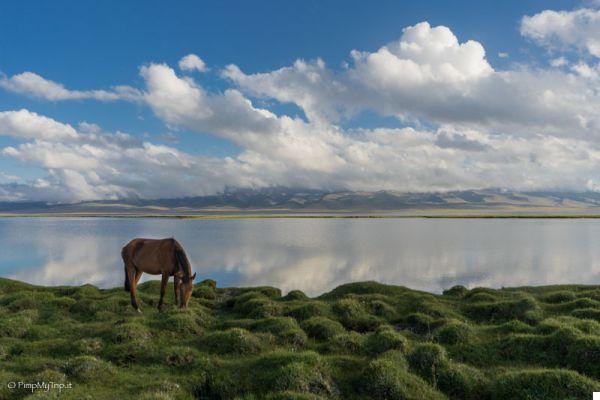
Song Kol is Kyrgyzstan's calling card
I have been in Kyrgyzstan for two weeks and although travelers generally spend less time in this country, I have many but still many things to see and discover. Despite being a small state, Kyrgyzstan offers endless valleys, mountains and waterfalls and many are still waiting to be discovered.
Jyrgalan
A little secret that you are now also aware of is this small village, about 60 km from Karakol which is one of the best destinations for trekking and horse riding. The Jyrgalan village it is immersed in a green valley dotted with fir trees and surrounded by high snow-capped peaks.
For any information, please contact Destination Jyrgalan or the guest-house Alakol where I have been: Emil and Gulmira, the two very kind owners will organize everything you need.
Police station
Known as the trekking capital of Kyrgyzstan, the small town of Police station it offers, in addition to the paths for which it is famous, also many beautiful experiences to dive into the Kyrgyz tradition such as the animal market, the bazaar or participate in a lesson on how local crafts are created. The ideal way to get to know it thoroughly is to spend at least a couple of days there.
Read 15 good reasons to visit Karakol!
Karakol is located east of Lake Issyk Kul and is known for the famous Altyn-Arashan trek, a two-day trek to Ala-kul Lake, a turquoise gem set at 3800 meters high.
From Karakol, however, the opportunities for other treks are certainly not lacking: we have done the 3 day trek known as Turnali-Ak Suu Trek. An amazing trek that starts from the Turgen-Aksu valley, crosses passes at more than 3600 meters in the wild mountains of Tien-Shan to the village of Ak-Syy. Strongly recommended!
Bokonbayevo
If you are looking for another destination off the beaten track of traditional tourism, head to Beltam Yurt Camp, just outside the town of Bokonbayevo, on the south side of Issyk-Kul.
The Beltam Yurt Camp, consisting of 15 yurts very close to the lake shore (you can even swim!) Is a family-run camp: the food is fantastic and the family that runs it is an example of what we mean when we talk of Kyrgyz hospitality.
Very impressive is the canyon Skazka, with its particular formations of red, orange and yellow rock with a thousand shades: go there at sunset when the soft light will make your photographs better.
In short, another destination not to be missed.
Dispassionate advice: if you travel by car from Jirgalan to Bokombayevo plan a stop at Barskoon waterfall!
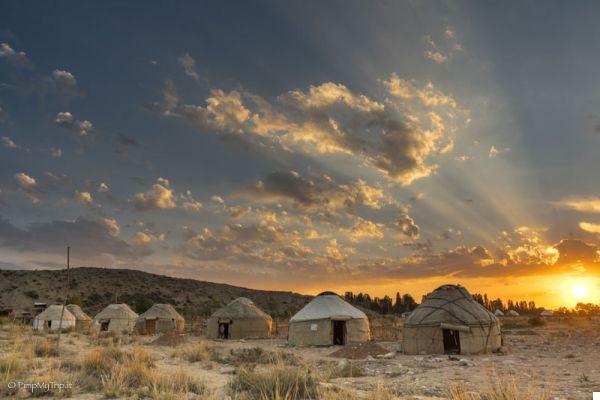
Yurte per turisti al Beltam Yurt Camp di Bokombayevo
Issyk Kul
The second largest alpine lake in the world (after Titicaca in South America) is a very popular destination for Kyrgyz, Kazakhs and Russians who come here to spend their holidays during the summer. Shan, Issyk Kul it is located about 170 km from Bishkek and is also easily accessible by public buses.
The lake is perfect for swimming, sunbathing and hiking.
Now (2019) it is possible book online 2 days in Issyk Kul (incluso il canyon) su Get Your Guide. The tour can be found HERE
Song Köl
Song Col. is a cobalt blue gem located in the mountains at 3016 meters: it is no coincidence that it is the visiting card of Kyrgyzstan and is a perfect destination for a three day horse trekking.
The lake is far from the cities and thanks to the clear evenings without pollution it offers unimaginable starry sky.
The starting point for Song Kol is the town of Kochkor about 60km from the lake and both CBT and Shepard's Life (Pionerskya St. tel: +996 0777 01 37 47) can organize the trek for you.
It can be booked 2 days tour from Bishkek to Song Kol and also includes other points of interest. Includes round-trip transportation, various visits, night in Song Kol's yurt camp (soooo local experience).
THIS IS THE TOUR, take a look!
Bishkek
At first glance Bishkek, the capital of Kyrgyzstan, could turn out to be the classic city of uninteresting Russian architecture.
But if you spend a few days there, among its wide streets shaded by tall trees you will realize that instead it is an interesting place to visit, full of lively cafes (and there is also a craft brewery!), Parks and monuments to visit. to see.
La largest city in Kyrgyzstan and the center of the country's economic, cultural and political life is an oasis in which to spend a few days and is one of the most interesting cities in all of Central Asia.
Lenin Peak
The highest peak of the Alay del Pamir is famous for being one of the 7000 most accessible in the world.
Officially her name is Koh-i-Garmo, but everyone keeps calling her Lenin Peak, its Soviet name.
Getting to the top is a feat for climbers and experienced people because although its snow-covered ridges are not a big problem, the risk of avalanches is (in 1990 an avalanche killed as many as 40 people) and the altitude sickness, an ailment that should not be taken lightly, since it too can cause death.
Regardless of Peak Lenin, the valley below, the Alay valley, offers practically endless trekking opportunities.
Experiences not to be missed
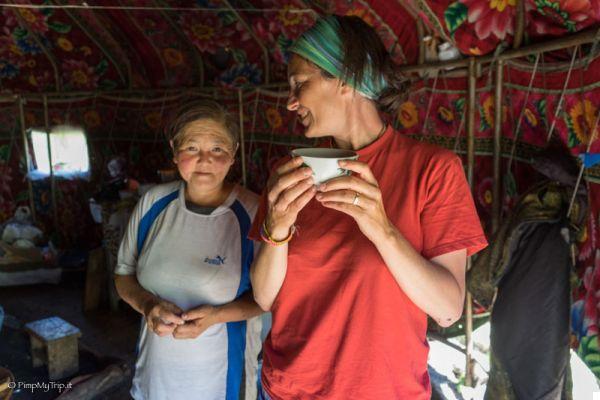
Kumis, or fermented mare's milk, is the traditional drink of the Kyrgyz nomads
Sleeping in a yurt and learning how to build one
Although many yurts are now used only for tourists (an example are those on the banks of Song Kol) the experience of sleeping in one of these "tents" of wood and felt is absolutely not to be missed.
Look for the ones in the non-touristy areas to get a real experience. The yurts are incredibly large and spacious, often heated by a dung stove (yes, it is not wood, but dry dung) and with comfortable mattresses covered with warm duvets.
During the day the mattresses are placed on the side of the yurt neatly folded to make room for the tables where breakfast, lunch and dinner are consumed… strictly seated on the ground with crossed legs on the carpets that cover the dirt floor.
Washing could be complicated: outside the yurts there are sinks with tanks for brushing your teeth, the rest will have to make do in the river. The toilets (actually better call them latrines) are outside and usually a deep hole dug in the ground. Bring toilet paper!
And if you want to learn how to build a yurt (or see how it's done) go to the village of Kyzyl -Tu: this is where the yurt building orders come from all over Kyrgyzstan as the craftsmen are the best in the whole country and they are famous for building yurts that last up to 100 years!
To book the visit send an email to: tolosunb@gmail.com
Read more: The Yurt, Symbol of Tradition and Nomadic Culture
Horse trekking
As in Mongolia and other Central Asian countries life in Kyrgyzstan is deeply linked to horses. There is certainly no shortage of opportunities throughout the country to organize a horseback ride, but in my opinion the best trek is the one that in three days starts from the small village of Kyzart, crosses the pass at 3700 meters and then descends to Song Kol.
I assure you that from the top of the pass the view of the blue waters of Song Kol will truly leave you breathless.
For other walks and unforgettable horse trekking make sure to go to the village of Jyrgalan and contact Gulmira at the email destination.jyrgalan@gmail.com to organize and ask for information.
Tell her that Martina from ForToursLovers sends you and you will receive a special treatment!
Trekking
With more than 94% of the land being mountains, Kyrgyzstan is often referred to as the "Switzerland of Central Asia" and there is certainly no better way to experience the country than to put on your hiking boots and walk.
Surely the best treks are in the mountains around Karakol (one of the most famous treks is without a doubt the 2 day excursion to Ala-kul lake, but I strongly recommend the trek. Turnali-Ak Suu ).
Other dream destinations for mountain walkers are Jyrgalan (try the new Keskenkija trail) and Song Kol.
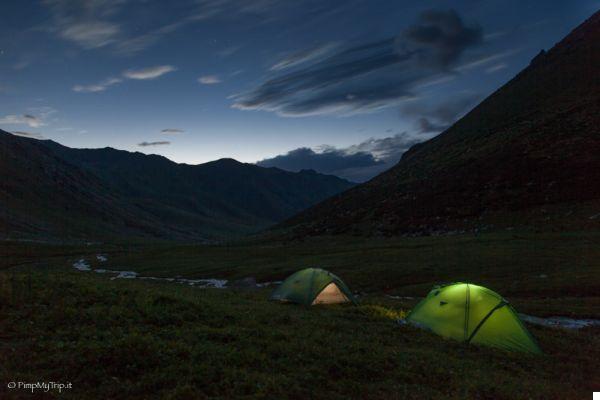
You can't really experience Kyrgyzstan if you don't dedicate a few days to trekking in its mountains
Drink the Kumis
Brace yourselves, drinking kumis is certainly the most adventurous olfactory-tasting experience not only of your trip, but of your life. kumis is fermented mare's milk and is one of the traditional drinks of nomads. It also seems to have remarkable purifying properties.
If you will be invited to some yurt (it will happen to you) it is a good idea to accept the invitation and surely you will also be offered a cup of kumis: do not refuse it and taste it.
I think the Kyrgyz people offer it to tourists because they enjoy seeing our faces with every sip. The taste is acrid and pungent with a trace of rancid. Best wishes!
Dine with a Dungan Family
A few km from Karakol, the village Deishan / Yrdyk, is one of the stops not to be missed especially because it bears the name of Dungan Village. The Dungan are a people who are descended from China from which they fled around 1880 to escape the religious persecutions of the Chinese and settle here while still maintaining their culture and traditions intact today.
The Dungans are famous for being excellent farmers, just think that their garlic (you will see millions of garlic cloves in the courtyards of their houses) is even exported to Russia.
One of the experiences that can be lived (reservations on the website of Destination Patrol) is dining in one of their homes. Does eight courses each seem like a lot? Think that they are the minimum that you will be served, arriving up to 12/13 courses each. For the Dungans, cooking is not just about putting something under your teeth, but a real philosophy according to which each dish must complement the others (a bit like family).
You will also have the opportunity to make your own Ashlan - Fu, the traditional Dungan dish!
Take a tour of a market
In every town you will go to Kyrgyzstan, you cannot fail to notice the great culture of the markets that is still widespread throughout the country: the bazaar Dordoi in Bishkek is one of the largest in all of Central Asia, as is theOsh Bazaar (also in Bishkeke) which is one of the most beautiful.
If you happen to be in Karakol during the weekend don't miss the animal market held every Sunday from about midnight until ten in the morning, as well as the used car market where you can find authentic relics of the old Soviet Union such as Lada, Niva, Moskvitch, Zhiguli, Volga and UAZ just to name a few.
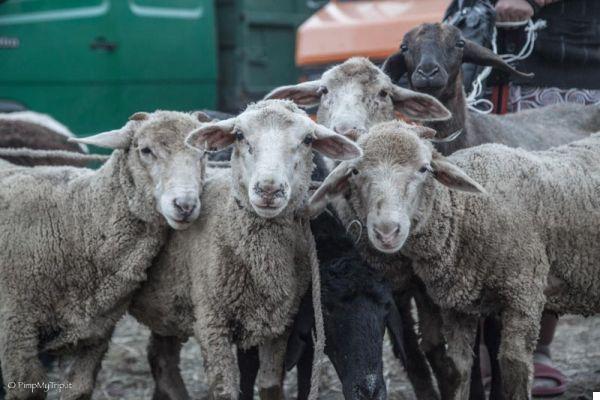
Karakol Animal Market
Relax on a beach to take a cruise on Issyk Kul at sunset
Although Kyrgyzstan is landlocked, that doesn't mean there are no sandy beaches on which to relax, sunbathe and take a dip in the azure waters. Head to Karakol and a few minutes drive will bring you to the sandy beaches of Issyk Kul with the white peaks of the Tian Shan chain in the background.
And to finish the day, book a romantic boat ride to watch the sunset from the center of the lake and sip a fresh Arpa beer!
How to book: you can book the cruise and get other information on the Destination Karakol website.
Take local craft lessons
After a few days in Kyrgyzstan one cannot fail to be fascinated by the colorful local craftsmanship: personally, to fully understand the Kyrgyz nomadic tradition, I took part in a lesson on how felt (with which yurts are also built) is worked.
Damira, the kind lady who gave us the lesson, offers various types of courses in Karakol. Damira told me how the tradition of making felt was passed on to her by her grandmother and how this helped her as a single mother to support herself and her family.
Today Damira in her school teaches, as her grandmother did with her, her profession by transmitting her great passion to other people.
To organize a handicraft lesson with Damira, contact Destination Patrol who will take care of planning your visit.
Participate in the World Nomad Games
Participating as spectators means! THE World Nomad Games they are a fairly new event (the first edition was held in 2014 in Cholpon-Ata) but they are also one of the most interesting cultural events you can attend.
The ideology behind the World Nomad Games is to preserve and showcase the rich nomadic tradition of not only Kyrgyzstan, but all of Central Asia.
The Kyrgyz people were once (and many still are today) a nomadic population whose existence was completely dedicated to animals: this meant “moving” as the seasons changed. During the summer the yurts dotted the green high-altitude pastures while in the winter they went down towards the valley.
There are many competitions and sports in which athletes face each other during the World Nomad Games, but for sure the kok boru (meaning gray wolf) is undoubtedly the strangest of all.
The Kok boru has a very ancient tradition: it is a match between two teams on horseback, it is a kind of polo only that instead of the ball a dead goat is used and the aim is to deposit it in the opponent's net.
The next World Nomad Games will be held in September 2018 (they are biennial). A good opportunity to start planning your next trip right now!
Dishes to Taste Absolutely
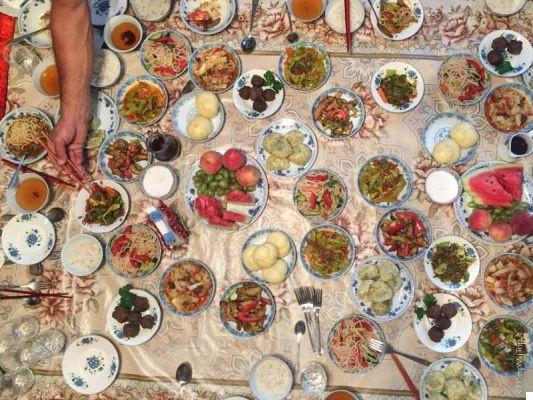
Does eight courses each seem like a lot? Do you think that at a Dungan dinner you will be served at least twelve or thirteen ...
Ashlan-Fu
Traditional dish of the Dungan people, Ashlan Fu is a cold dish made from rice noodles in a vinegar broth and topped with strips of potato starch, chilli, parsley and a gravy (optional, vegetarians can ask for it without).
Shashlik
The Central Asian version of the Kebab. They are skewers of meat cooked on the grill, generally of lamb or beef, but they are also found mixed and of chicken.
Chechevitsa
A vegetarian dish, chechevitsa is a lentil soup, which (if desired) can be seasoned with lemon. The best I have eaten can be found at Cafe Zarina in Karakol.
Lagman
Surely during a trip to Kyrgyzstan you will find lagman on the menus (and you will eat a lot of them since they are fantastic), which is a dish of homemade noodles (spaghetti) and seasoned with meat (generally) but which can also be vegetarian.
Lagman are of 3 types: boso lagman (fried), traditional lagman (in broth) and guyru lagman (less broth and not fried).
Transport and how to get there
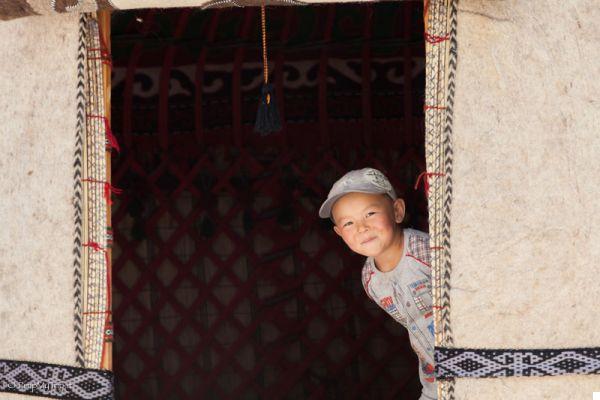
One of the experiences not to be missed is the encounter with people
One of the major dangers traveling in Kyrgyzstan are undoubtedly road accidents, since Kyrgyz drivers have a passion for stepping on the accelerator pedal. Fortunately for tourists, CBT organizes shared taxis that connect the country's main destinations.
If, on the other hand, you want to experience the thrill of public transport, remember to bargain on the price anyway.
By plane
The international airport of Bishkek (Manas airport) has flights that connect the capital of Kyrgyzstan daily to Moscow, the London (via Almaty in Kazakhstan) e Istanbul.
I low cost flights from Pegasus from Europe and visa-free entry for Spanish citizens makes Kyrgyzstan the main gateway to Central Asia.
There are also weekly flights from Urumqui (China), Tashkenk (Uzbekistan) e Dubai.
You can book your transfer from the airport to Bishkek HERE in advance
By land
To and from Russia: There are trains two or three times a week from Moscow's Kazanskaia station. The journey takes about 3 days (3714 km) and the train crosses Kazakhstan so you will need to apply for a visa before traveling.
To and from Kazakhstan: There are numerous buses every day and shared taxis connecting Almaty and Bishkek in both directions.
A problem can be the corruption of the border police, so it could take several hours to get through. Fortunately, there are minibuses that connect the borders to the city.
To and from Tajikistan: the best choice if you want to start from Osh and continue in Tajikistan along the famous High Pamir Road, is to take a private driver or to rely on a local agency.
If, on the other hand, you want to do it by your own means, don't forget to apply for the GBAO permit first.
To and from China: there are two steps that can be taken on the Tian-Shan chain to move to or from China: the easiest way is to cross the Irkeshtam pass, for the more adventurous there is the Torugart pass.
To and from Uzbekistan: There are 3 ways to travel between Uzbekistan and Kyrgyzstan. The first that is the one most used by tourists is the Dostyk border and is located on the road that connects Osh and Andijon. The second border is that of Khanabad on the road between Osh and Jalal-Abad.
The third, which is the easiest to reach, is the Uch Kurgan border between Karakol and Namangan. Before deciding where to go, find out how often borders close without notice.
Public transport
I public transport in Kyrgyzstan they are of two types: i shared taxis and marshrutkas which are minibuses. Both leave when they are full: if you don't want to wait then you can also pay for the other seats and travel more comfortably.
The price is low and not fixed because it depends on both seasonality and fluctuations in the price of oil.
Marshrutkas are cheaper but also slower.
In Bishkek there are two bus stations: the Eastern Bus Station from which mostly city buses leave or go to areas adjacent to the city and the Western Bus Station from where buses leave for most destinations in the country and also for the borders.
Stay away from the clubs and bars around the stations: the Swiss guys I met (and who were drugged and beaten) had their bad experience in a club near this station.
Another way to get around the country between major destinations, such as between Bishkek and Osh, is with i commercial pickup trucks: they are cheap, travel at night and have bunks to sleep in. The two downsides are the little security and the fact that you lose the fantastic views from the window.
Safety
Personally I have not had any problems with security in Kyrgyzstan, but I met some Swiss guys who had had bad encounters at night on the outskirts of Bishkek so paying attention is essential and especially after 23pm it is strongly recommended to use taxis. You can have them call from the hotel or restaurant.
The guys we met they were drugged and beaten up and ended up in hospital (seen with my own eyes the marks on the face of the blows they took)
La police are often corrupt and it can represent a problem for which it is better to be careful and not expose yourself especially at the borders.
We must also pay close attention to the plainclothes police in the markets: if they ask for your passport, show them a copy, it is not uncommon for it to be seized and released only in exchange for hard cash.
One of the biggest health risks is food poisoning and the consequent diarrhea, so it is necessary to carry antibiotics, intestinal disinfectants and have travel insurance. Before leaving, therefore, contact your doctor and ask for advice on what to bring with you.
Even if there are mosquitoes there is no danger of dengue or malaria.
There have been cases of dogs (you will see many strays on the streets of Karakol) and cats sick with rabies so be careful and don't pet them.
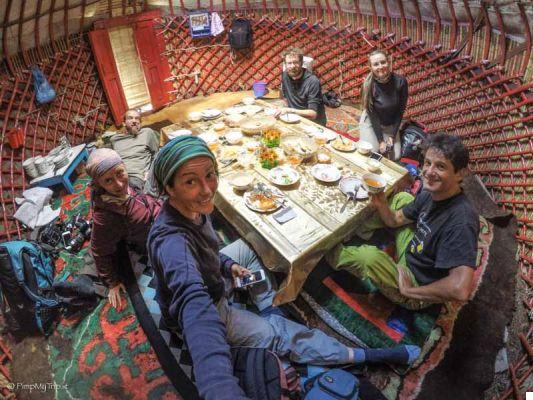
Kyrgyzstan is a pretty safe country so have a nice trip!
Disclosure: my experience in Kyrgyzstan is the result of a USAID (United States Agency for International Development) tourism development project. The contents are solely the responsibility of the author and do not necessarily reflect the views of USAID or the United States Government: as always, all thoughts and information, the how, what and why, are entirely personal.




